实例分析参考 http://www.blogjava.net/rosen/archive/2010/06/13/323522.html
http://eclipsesource.com/blogs/2013/01/21/10-tips-for-using-the-eclipse-memory-analyzer/
一、首先理解几个概念
Shallow Heap Size
指对象自身所占用的内存大小,不包含其引用的对象所占的内存大小。
1、数组类型
数组元素对象所占内存的大小总和。
2、非数组类型
对象与它所有的成员变量大小的总和。当然这里面还会包括一些java语言特性的数据存储单元。
Retained Heap Size
前对象大小+当前对象可直接或间接引用到的对象的大小总和。
(间接引用的含义:A->B->C, C就是间接引用)
换句话说,Retained Size就是当前对象被GC后,从Heap上总共能释放掉的内存。
不过,释放的时候还要排除被GC Roots直接或间接引用的对象。他们暂时不会被被当做Garbage。GC Roots直接引用了A和B两个对象。
A对象的Retained Size=A对象的Shallow Size
B对象的Retained Size=B对象的Shallow Size + C对象的Shallow Size这里不包括D对象,因为D对象被GC Roots直接引用。
如果GC Roots不引用D对象呢?
GC Roots
The so-called GC (Garbage Collector) roots are objects special for garbage collector. Garbage collector collects those objects that are not GC roots and are not accessible by references from GC roots.
There are several kinds of GC roots. One object can belong to more than one kind of root. The root kinds are:
- Class - class loaded by system class loader. Such classes can never be unloaded. They can hold objects via static fields. Please note that classes loaded by custom class loaders are not roots, unless corresponding instances of
java.lang.Classhappen to be roots of other kind(s).- Thread - live thread
- Stack Local - local variable or parameter of Java method
- JNI Local - local variable or parameter of JNI method
- JNI Global - global JNI reference
- Monitor Used - objects used as a monitor for synchronization
- Held by JVM - objects held from garbage collection by JVM for its purposes. Actually the list of such objects depends on JVM implementation. Possible known cases are: the system class loader, a few important exception classes which the JVM knows about, a few pre-allocated objects for exception handling, and custom class loaders when they are in the process of loading classes.Unfortunately, JVM provides absolutely no additional detail for such objects. Thus it is up to the analyst to decide to which case a certain "Held by JVM" belongs.
二、官方关于如何使用MAT的说明
Memory Analyzer > Getting Started
Basic Tutorial
This tutorial provides a "jumping-off place" to get familiar with Memory Analyzer.
Step 1 - Getting a Heap Dump
The Memory Analyzer works with heap dumps . Such a heap dump contains information about all Java objects alive at a given point in time. All current Java Virtual Machines can write heap dumps, but the exact steps depend on vendor, version and operation system. Find out more in the section Acquiring Heap Dumps .
Open  a sample heap dump if you view this page inside the Eclipse help center.
a sample heap dump if you view this page inside the Eclipse help center.
For the purpose of this tutorial, we use Java 6 and JConsole on Windows. Start your application with Java 6, then start <jre6>/bin/jconsole.exe and select the running application (in this case Eclipse):
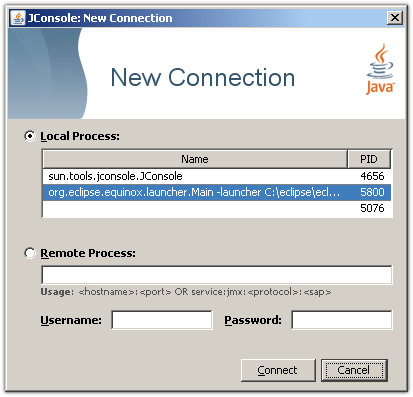
Then, select the operation dumpHeap from the com.sun.management.HotSpotDiagnostic MBean. The first parameter p0 is the full path to the heap dump file. Make sure you give it the file extension .hprof. The second parameter p1 should be left at true as we are only interested in live objects.
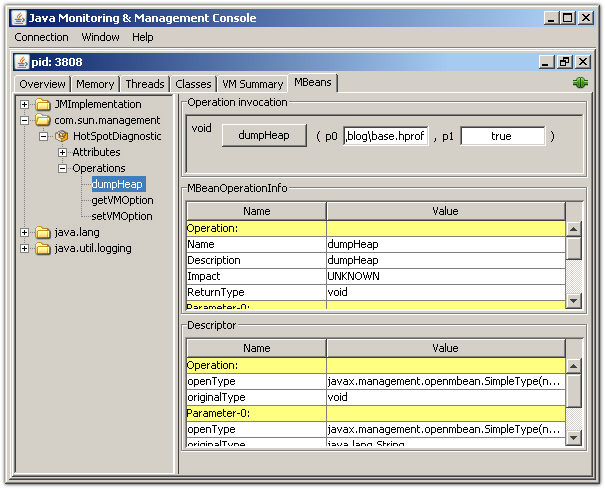
Step 2 - The Overview
Open the heap dump via File >  Open Heap Dump... to see the overview page.
Open Heap Dump... to see the overview page.

On the right, you'll find the size of the dump and the number of classes, objects and class loaders.
Right below, the pie chart gives an impression on the biggest objects in the dump. Move your mouse over a slice to see the details of the objects in the object inspector on the left. Click on any slice to drill down and follow for example the outgoing references.
Step 3 - The Histogram
Select the histogram from the tool bar to list the number of instances per class, the shallow size and the retained size .
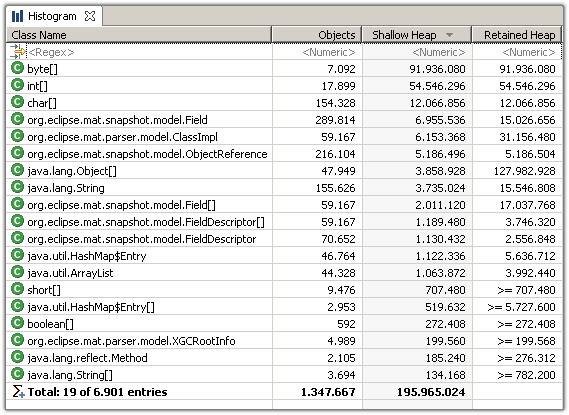
The Memory Analyzer displays by default the retained size of individual objects. However, the retained size of a set of objects - in this case all instances of a particular class - needs to be calculated.
To approximate the retained sizes for all rows, pick  icon from the tool bar. Alternatively, select a couple rows and use the context menu.
icon from the tool bar. Alternatively, select a couple rows and use the context menu.

Using the context menu , you can drill-down into the set of objects which the selected row represents. For example, you can list the objects with outgoing or incoming references. Or group the objects by the value of an attribute. Or group the collections by their size. Or or or...
One thing that makes the Memory Analyzer so powerful is the fact that one can run any action on any set of objects. Just drill down and slice your objects the way you need them.

Another important feature is the facility to group any histogram by class loader, packages or superclass .

Any decent application loads different components by different class loaders. The Memory Analyzer attaches a meaningful label to the class loader - in the case of OSGi bundles it is the bundle id. Therefore it becomes a lot easier to divide the heap dump into smaller parts.
More: Analyze Class Loader

Grouping the histogram by packages allows to drill-down along the Java package hierarchy.

Grouping the histogram by superclass provides an easy way to find for example all the subclasses of java.util.AbstractMap, etc...

Step 4 - The Dominator Tree
The dominator tree displays the biggest objects in the heap dump. The next level of the tree lists those objects that would be garbage collected if all incoming references to the parent node were removed.
The dominator tree is a powerful tool to investigate which objects keep which other objects alive. Again, the tree can be grouped by class loader (e.g. components) and packages to ease the analysis.
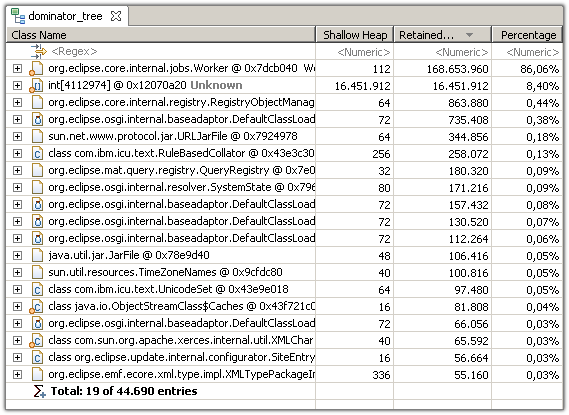
Step 5 - Path to GC Roots
Garbage Collections Roots (GC roots) are objects that are kept alive by the Virtual Machines itself. These include for example the thread objects of the threads currently running, objects currently on the call stack and classes loaded by the system class loader.
The (reverse) reference chain from an object to a GC root - the so called path to GC roots - explains why the object cannot be garbage collected. The path helps solving the classical memory leak in Java: those leaks exist because an object is still referenced even though the program logic will not access the object anymore.
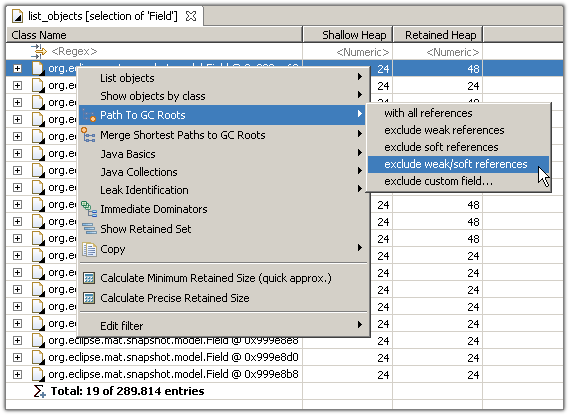
Initially, the GC root reached by the shortest path is selected.
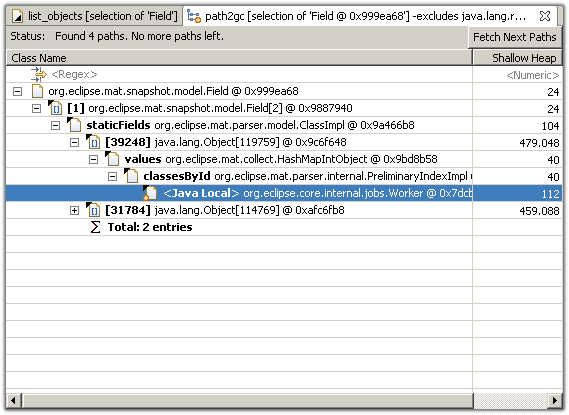
Step 6 - The Leak Report
The Memory Analyzer can inspect the heap dump for leak suspects, e.g. objects or set of objects which are suspiciously big.

Learn more in this blog posting: Automated Heap Dump Analysis: Finding Memory Leaks with One Click .
Related concepts
来源:oschina
链接:https://my.oschina.net/u/2308739/blog/705156

